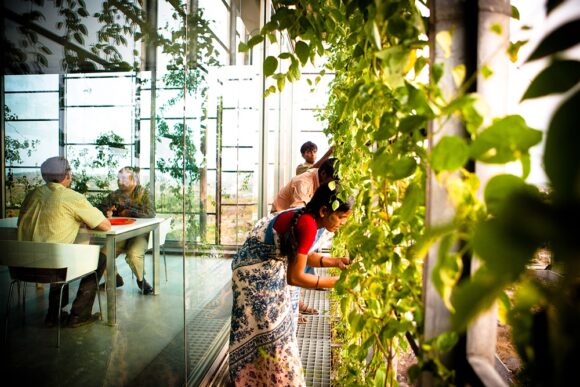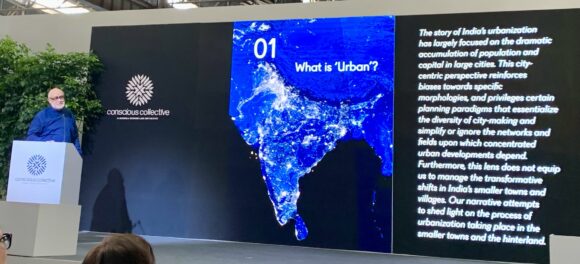
Rahul Mehrotra does not let the fact that he is one of the best established and most respected architects in India get in the way of his appetite for critical research and provocative positions. A talk he gave at Godrej’s Conscious Collective event in Mumbai was the chance to get a dose of his youthful energy and stimulating reflections.
Mehrotra is a bit destabilizing because the concepts he champions, like impermanence and fluidity, would seem at first view to be a negation of a traditional architectural practice altogether. Yet he certainly does produce designs for buildings – in addition to his rich teaching, research, and advocacy work.
The implication of these concepts for him is not to avoid designing buildings, but to be more thoughtful in the designs in a couple of ways. One is to consider whether hard and irreversible designs are really necessary – as he puts it “are we creating permanent solution to a temporary problem?”. Another is to soften his designs, particularly in their edge conditions, and to be very open-minded about uses, as he illustrated through some examples of his work.
What he wishes to get away from is what he calls the “brittle architecture” of “impatient capital”. He wants his architecture to be adaptable and durable in a much deeper sense, which includes a genuine culturally-grounded approach to the environment that includes a need for social relevance. Part of achieving that is to figure out how to make capital more “patient”, to achieve a dialogue with clients that gets them to shift their paradigms.

Mehrotra has strong views about sustainability. “Sustainability has become an unproductive category. We have created the dumbest box and then we mobilize the tools and technology to solve it.” In saying this, he is underlining the need for a thinking on appropriateness of design that goes beyond the superficial notions of sustainability that the word now often conveys. It goes back to the need he sees for impermanence, flexibility, and resilience. “Architecture,” he feels, “has not been sufficiently responsive to ecological imperatives. Architecture reinforces stability. It has not translated the energy of these transitions into its forms.” For him, sustainable design means accompanying the dynamic and fluid nature of the changes that will occur.
At the risk of shocking people, Mehrotra sees the rising sea level as an opportunity for the urban planning of Mumbai. It is a chance to again be thoughtful in a strategic sense to achieve an ecological realignment. This would lead to thinking about the position of the natural infrastructure and then building the city in the interstitial spaces, rather than carrying on doing just the opposite, i.e. building densely without regard to nature and letting nature occupy the interstitial spaces. This aptly describes a change in thinking that may or may not take hold – with immense consequences for Mumbai.

Mehrotra presented ongoing research work on urbanization in India. The way the census defines cities leads to a blind spot regarding many settlements that are functionally urban but that are treated and administered as rural and therefore do not receive funds to support urban development. If we have the wrong data and therefore do not think about things the right way, we will not locate investments where we should. It sounds like these “transitional settlements” – which are clearly pivotal in India’s future – are going to be an area of focus for Mehrotra in the coming years.
Another similar problem he identifies regards the concentration of housing production on permanent homes with standard product types. He estimates that there are 300 million people in flux in India in one way or another, for whom the 1BHK or 2BHK solutions do not align to the need. Again, this is a population that is hard to capture in statistics with a subtlety of requirements that is hard to understand, and therefore at risk of falling through the cracks.
To conclude, I was struck by Mehrotra’s view of the need for each us, as designers, to distinguish between our sphere of concern – which is typically growing – and our sphere of influence – which, as architects who design, is generally shrinking. He emphasizes the need for each of us to manage that disparity, and to do that is by carefully considering our modes of engagement. This is a deep issue of ethics and personal alignment for many of us in the design world.
Beyond the unhelpful tagline of sustainability, it is inequity that Merhotra believes to be the greatest issue we will face as designers in the coming decades. Therein is a deep challenge. It is up to each of us to look inside ourselves to consider what designing in a context of inequity means to us and how we choose to respond.